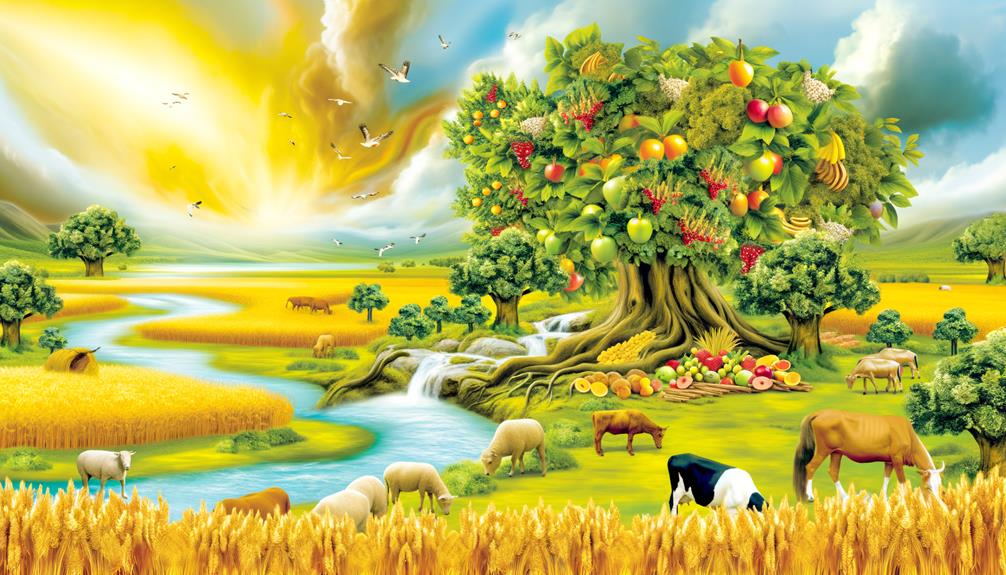A Land Flowing With Milk and Honey Bible Verse Meaning
The phrase ‘a land flowing with milk and honey’ in the Bible, found in Exodus, Leviticus, Numbers, and Deuteronomy, denotes God’s promise of abundance and divine providence to the Israelites. Historically, it contrasted their nomadic hardships with the agricultural wealth of Canaan, a land rich in resources.
Theologically, it symbolizes God’s covenantal faithfulness and His intention to provide both physical and spiritual sustenance. Metaphorically, milk represents pastoral wealth while honey signifies agricultural bounty, together portraying a divinely promised utopia.
By exploring further, one gains a richer understanding of its enduring significance and modern application.

Key Takeaways
- The phrase ‘a land flowing with milk and honey’ signifies God’s promise of prosperity and abundance to the Israelites.
- It symbolizes divine providence and the fulfillment of God’s covenant with His people.
- The metaphor highlights physical and spiritual nourishment, representing agricultural and pastoral wealth.
- It illustrates God’s faithfulness and care, encouraging trust and obedience among believers.
A Land Flowing with Milk and Honey Bible Verse Meaning: God’s Promise of Abundance
| Aspect | Explanation |
|---|---|
| Source | The phrase appears in Exodus 3:8, where God describes the Promised Land of Canaan |
| Abundance | Symbolizes prosperity and the richness of God’s blessings upon His people |
| Fertility | Refers to a land of great natural resources, indicating agricultural abundance (milk from livestock and honey from bees) |
| Divine Provision | Represents God’s care, provision, and the fulfillment of His promises |
| Spiritual Promise | More than physical wealth, it reflects spiritual abundance and God’s favor on those who follow Him |
Biblical Occurrences

The phrase ‘a land flowing with milk and honey’ appears multiple times in the Bible, particularly in the books of Exodus, Leviticus, Numbers, and Deuteronomy, serving as a divine promise of prosperity and abundance to the Israelites.
This expression encapsulates God’s assurance of a fruitful and fertile territory, symbolizing both physical sustenance and spiritual fulfillment.
In Exodus 3:8, God speaks to Moses, indicating His intention to deliver the Israelites from Egyptian bondage into a land of unparalleled richness.
Similarly, Leviticus 20:24 emphasizes the covenantal aspect, where the land’s bountiful nature is a reflection of God’s unwavering commitment.
Each occurrence reinforces the theological promise of divine providence, positioning the land as an ultimate reward for faith and obedience.
Historical Context

Understanding the phrase ‘a land flowing with milk and honey’ necessitates exploring the historical and geographical realities of ancient Canaan, providing context to the divine promise made to the Israelites.
This metaphor symbolized abundance and prosperity, reflecting Canaan’s agricultural wealth and fertility. The Israelites, originally nomadic, yearned for a permanent homeland, contrasting their arduous desert wanderings with the promise of Canaan’s bountiful resources.
| Contextual Aspect | Explanation |
|---|---|
| Historical Background | Nomadic Israelites seeking a fertile homeland |
| Agricultural Promise | Canaan’s fertility symbolized by ‘milk and honey’ |
| Socio-Economic Implication | Prosperity and stability promised in Canaan |
| Cultural Contrast | From desert hardships to agricultural abundance |
| Theological Significance | Divine fulfillment of God’s promise to His people |
This promise underscored God’s providence and fidelity, forging a hopeful vision for the Israelites’ future.
Geographical Significance

Situated at the crossroads of ancient trade routes, Canaan’s geographical significance extends beyond its fertile plains and abundant resources, offering strategic value that shaped its historical and theological importance.
Its location between major civilizations such as Egypt and Mesopotamia rendered it a critical nexus for commerce and cultural exchange.
The region’s diverse topography, from coastal plains to mountainous terrains, provided varied agricultural opportunities that fulfilled the promise of a ‘land flowing with milk and honey.’
This geographical diversity not only supported a thriving agrarian economy but also reinforced the theological narrative of divine providence.
In addition, Canaan’s strategic position made it a contested territory, influencing the sociopolitical dynamics that permeate biblical accounts and underscore its enduring significance.
Symbol of Abundance

In biblical theology, the phrase ‘a land flowing with milk and honey’ epitomizes a divine promise of abundance and prosperity, encapsulating the fertility and richness that awaited the Israelites in Canaan.
Historically, milk symbolizes pastoral wealth, indicative of flocks thriving, while honey, often derived from dates or wild bees, signifies agricultural bounty. This metaphor communicated to an agrarian society the promise of a land where sustenance and luxury were readily available.
Theologically, it underscores God’s providence and the transformative potential of divine favor. The imagery of flowing substances suggests effortless and continual provision, contrasting the Israelites’ previous hardships in Egypt and the wilderness, hence reinforcing a vision of an ideal, divinely-granted homeland.
Theological Interpretation

The theological interpretation of ‘a land flowing with milk and honey’ explores its representation of divine benevolence and covenantal faithfulness, reflecting God’s unwavering commitment to fulfill His promises to the Israelites.
Historically, this phrase signifies the Promised Land, a divine gift symbolizing abundance and prosperity.
Theologically, it underscores God’s grace and steadfast love in guiding the Israelites from bondage to freedom. This journey is a powerful example of God’s faithfulness and provision throughout history. A biblical context exploration reveals the intricate ways in which God works in the lives of His people, showing mercy and demonstrating His power. It is a reminder that God’s grace is always available to lead us from our own places of bondage to freedom.
This promise of a bountiful land serves as a proof of God’s reliability and care, reinforcing the covenant made with Abraham.
It conveys that God’s blessings are both material and spiritual, providing sustenance and nurturing faith.
Consequently, it represents a holistic vision of God’s provision, embodying both physical nourishment and spiritual fulfillment.
Cultural Impact

The phrase ‘a land flowing with milk and honey’ has transcended its biblical origins to become a powerful cultural symbol in both ancient and modern contexts.
In ancient Israel, it represented divine promise and abundance, embodying the covenant between God and His people.
Today, this metaphor continues to resonate, often signifying prosperity and fulfillment in various theological and secular interpretations.
Symbolism in Ancient Israel
Understanding the phrase ‘a land flowing with milk and honey’ necessitates an exploration of its profound cultural symbolism in Ancient Israel, reflecting both the promised abundance and divine favor bestowed upon the Israelites.
This evocative imagery, found frequently in the Pentateuch, underscores the fertility and prosperity awaiting the Israelites in Canaan, contrasting sharply with their experience in Egypt and the wilderness.
Milk symbolizes sustenance and nourishment, derived from livestock, while honey signifies natural sweetness and the bounty of the land. Together, these elements highlight a utopian vision of divine provision.
Theologically, this promise reinforced the covenantal relationship between God and His people, fostering hope and faith during periods of hardship and wanderings.
This symbolic assurance was foundational in shaping Israelite identity and collective memory.
Modern Interpretations Today
In contemporary times, the phrase ‘a land flowing with milk and honey’ transcends its ancient origins, serving as a powerful metaphor in both religious and secular contexts for abundance, prosperity, and divine blessing.
This expression, rooted in the biblical description of the Promised Land, has evolved to symbolize idealized visions of success and well-being.
Theologically, it continues to underscore God’s provision and favor, frequently invoked in sermons and spiritual discourses.
Culturally, it permeates literature, politics, and economics, symbolizing utopian ideals and societal aspirations.
The enduring resonance of this phrase attests to its rich historical and spiritual connotations, embodying humanity’s perennial quest for a bountiful and blessed existence, transcending time and geographical boundaries.
Modern Relevance

In contemporary times, the biblical metaphor of ‘a land flowing with milk and honey’ can be interpreted as a symbol of spiritual abundance and divine provision accessible to believers today.
This phrase, historically situated in the context of Israel’s promised land, now serves as an allegory for the manifold blessings and sustenance available through a life of faith.
Theological reflection on this imagery reveals its enduring relevance, emphasizing that divine promises continue to offer hope and sustenance in an ever-changing world.
Metaphorical Promises Today
The metaphorical promise of a ‘land flowing with milk and honey’ continues to resonate today, symbolizing divine provision and the abundance awaiting those who live in accordance with spiritual principles.
Historically, this phrase referred to the fertile and prosperous land of Canaan, a divine gift to the Israelites. Theologically, it underscores God’s faithfulness and the rewards He bestows upon His followers.
In modern times, this metaphor extends beyond physical prosperity to encompass spiritual and emotional well-being.
- Represents enduring hope and divine favor
- Emphasizes the importance of faith and obedience
- Symbolizes holistic abundance, including peace and joy
Understanding this promise helps believers navigate contemporary challenges with a sense of divine assurance.
Spiritual Abundance Now
Drawing from the historical and theological significance of the ‘land flowing with milk and honey,’ contemporary believers can find a profound sense of spiritual abundance in their daily lives through unwavering faith and adherence to spiritual principles.
Historically, this phrase encapsulated God’s promise of provision and prosperity to the Israelites. Theologically, it represents divine favor and an intimate relationship with God.
Modern relevance lies in recognizing that spiritual abundance is not merely material wealth but encompasses inner peace, wisdom, and a deep sense of purpose.
Personal Reflections

Reflecting on the phrase ‘a land flowing with milk and honey,’ one cannot help but consider its profound implications for both the ancient Israelites and contemporary believers. This evocative imagery highlights not only the fertility and abundance of the Promised Land but also symbolizes divine providence and faithfulness. It invites personal reflection on the following themes:
Historical context: Understanding the socio-economic conditions of ancient Canaan and its agricultural richness.
Theological insight: Recognizing God’s covenantal promise and its fulfillment in providing a bountiful land.
Spiritual lesson: Contemplating how divine blessings manifest in our lives today.
Personal application: Reflecting on how this promise encourages trust in God’s provision amidst current uncertainties.
These reflections foster a deeper appreciation of the enduring relevance of this biblical promise.
Conclusion
‘A land flowing with milk and honey’ serves as a vivid metaphor representing abundance and divine providence.
Rooted in biblical text, it encapsulates not just geographical fertility but also spiritual promise and fulfillment.
Historically, it underscored the Israelites’ journey towards a promised utopia.
Theologically, it signifies God’s covenantal faithfulness.
Its cultural resonance persists, symbolizing prosperity and hope.
Consequently, the phrase remains a beacon of divine assurance and human aspiration through the ages.






